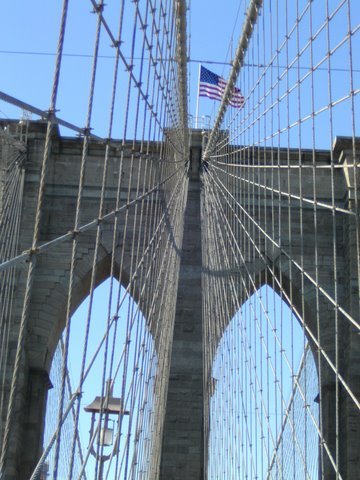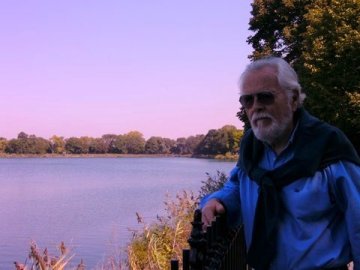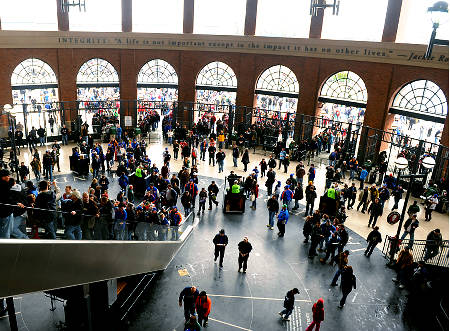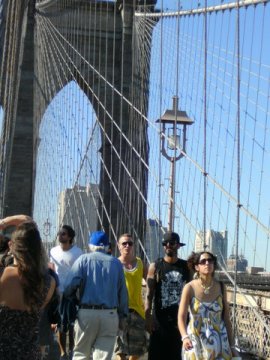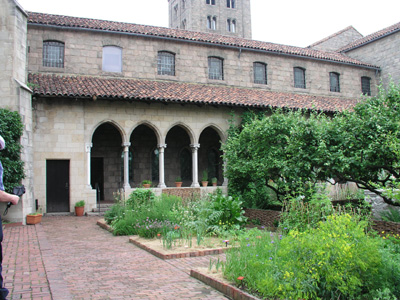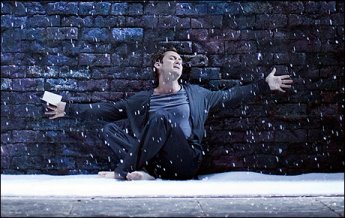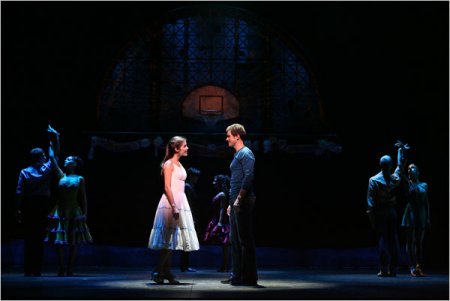Editor�s Page
Who says: �You can�t go Home Again?�
Actually it was Thomas Wolfe, but he was talking about Ashville, North Carolina, not Brooklyn, although he also had something to say about the latter in Only the Dead Know Brooklyn.
This is a travel article of sorts, so hold onto your hats. My wife and I went to my old hometown, New York City, for a brief visit. And when I say �old� hometown, it couldn�t be more true. I was born and bred in Brooklyn, but left many moons ago and have only been back to the Big Apple on occasional visits. But let�s start at the beginning.
My wife is Argentine � in Americo-speak an �alien�, although as far as I know she�s never been to another planet. The last time she applied for a visitor�s visa was in 2002, when the 9/11 panic paranoia was still shaking the foundations of the home of the brave. She went to the consulate with all the pertinent documents proving that she was indeed an earthling. The place was a chaos and when after hours of waiting, despite having an appointment at a specific time, the employee who interviewed her took one look at her application and stamped it denied. �But��my wife began� �No buts! Next.� She said it was humiliating. I tried to call the consulate but it was impossible, all I got was a recording saying to contact them by email. I somehow found out the consul�s name and sent an email to him, maintaining that as a U.S. citizen I had the right to have my wife accompany me on a visit to my patria. And furthermore that there was no reason to deny her application even if that had not been the case. No reply. But I wasn�t giving up. I sent three emails a day for a week until finally a reply came saying that I should go to the consulate with her passport and ask for his secretary, Ms. So-and-so. I went, elbowed my way through the mob of suspicious-looking aliens to a window and asked for Ms. So-and-so. She came a few minutes later looking hurried and harried. She smiled, took the passport and disappeared. Another ten minutes went by, she returned and handed me the passport with a visa valid for ten years. �Sorry for the inconvenience,� she said, �but we�re sooo overloaded with work.� I smiled back, humbly I fear, as though she�d done me a big favor.
This year when we were going again, seven years had passed, so her visa was still valid. However! The passport containing the visa had expired. This happens all the time, everywhere. The solution is obvious: bring the old passport along. However! If the visa has been damaged or altered in any way, a new one must be obtained. When expired Argentine passports are renewed, they clip a corner off the old one. As the U.S. visa takes up an entire page, inevitably a small corner of the visa is also clipped. The consulate knows this very well, but insists that a new visa must be obtained, including all the rigmarole. My wife said: if the same thing happens I�m not going � and I didn�t blame her. A friend of mine was a purser for Argentine Airlines and already had a crew visa and a tourist visa, but in 2002 they told him they would have to be renewed. He went to the consulate: denied. �What?� he said. �No buts!..Next.� He grabbed his passport and yelled, �I�m never going to your fucking country again!�
But that was 2002, when my wife returned to the consulate in 2009, everything was well organized, interview times were respected, the interviewers seemed to be Spanish-speaking Americans, and she was out in a half-hour with a new ten-year visa. Progress!
A few months ago when the Air France Airbus went down over the South Atlantic and a short time later a Yemenia plane crashed in Coromos, I watched an air traffic �expert� on TV answer a question about what travelers should do to be safe on airlines. He recommended avoiding �third world airlines� � despite Air France�s first-world credentials. Nevertheless we travelled on one of the best airlines operating: LAN Chile. Modern aircraft, excellent on-time and safety records and service. The food? Let�s not talk about that. We live 200 kilometers from the nearest airport city � C�rdoba. From there we took LAN to Santiago, Chile, a one and a half hour flight, then non-stop to JFK, ten hours in a Boeing 767, which provides more leg-room than a 747 and the left and right rows contain only two seats. And you get a great view of the Andes.
At JFK the immigration officer scowled at my wife�s passport. (Aliens are never truly �in� until they�re in.) Until I told him that I liked his uniform. (He looked like a North Korean general.) �You do?� he smiled. �It�s new� � and stamped her passport, took her fingerprints and photo and wished us a nice stay.
Day one (Friday): My ex-foster son, Marcel, picked us up at JFK. He was with my family from 8 years old till he was grown, in Switzerland and Germany. He�s originally Venezuelan, now lives (legally, btw) in New York. He led us to the parking lot and stopped before a shiny Mercedes coup�. �Hey, Marcel,� I said, �that�s a Mercedes!� �Yeah,� he answered in perfect New York-ese. �Sorry.�
He had found us an apartment in Washington Heights for $300 a week, two large rooms, a large kitchen. In a city where you pay that much per day for a hotel room, it was a real bargain. Jet-lagged, all we did that day was have lunch with Marcel in our new neighborhood � and what a neighborhood. Everyone was speaking Spanish, most stores had bilingual names. It turns out that a large part Washington Heights has become a Dominican (Dominican Republic) enclave in New York, with Broadway (note: originally from the Dutch Brede Weg meaning Broad Way) being the dividing line between Dominica and Yeshiva. Our apartment was one block on the Jewish side of Broadway, but even there the great majority of shops seemed to be in Dominican hands, or at least run by Dominican employees. (Who knows who owns what nowadays?)
Day two (Saturday):
Despite the Mets being in fourth place and already eliminated from the playoffs, seeing them play at least one game and visiting the new stadium, was one of my priorities. The Mets floundered horribly this year, mostly because of injuries, especially to their premium players, Jos� Reyes, Carlos Delgado and Carlos Beltr�n. Another reason, perhaps the principal one, is the new stadium�s name. The fans wanted it to be called Jackie Robinson Field, but Citibank paid millions to have it named Citi Field � and money talks�but so does karma.
Playing listlessly that day, the Mets won against the Washington Nationals, the worst team in major league baseball, so that was a small satisfaction. We were originally seated too far away down the left field line, because I thought that $50 a seat was enough to be well seated. It just shows how long it had been since I was in New York. There were still empty seats closer to home plate, so I went down to the ticket window to buy an upgrade. While on line a guy came up to me and offered to sell two tickets. I said, no, I already had tickets, only wanted an upgrade. �Here,� he said, �take them for nuttin�, we�re goin� home.� So we wound up with better seats after all.
Day 3. Sunday: I wanted to see the places where I grew up in Brooklyn. Mar�a Teresa was interested as well. So we took the subway, intending to get off at Newkirk Avenue in Brooklyn. (Btw, we had Metropasses, with which we could ride the whole New York transit system without limits � subways and buses � at $27 a week, and the system goes everywhere you could possibly want to go.) But at Prospect Park the P.A. system announced that this train would end here because of maintenance work ahead. Buses are waiting at street level. Moans and groans. We couldn�t care less though, we weren�t in a hurry. A line of air conditioned buses was indeed waiting for us at street level � express and local, imitating the subway stops. We got off at Newkirk Ave. after all, but from the bus. East 22nd Street, a dead-end where I lived as a boy from about 9 to 13 years of age, was the same and changed, like a middle-class lady grown old and down on her luck. Everything looked smaller to me, but that�s not surprising. The inhabitants � the ones we saw on the street at least � were all black. No children though, which seemed strange because way back then the street was swarming with kids taking advantage of there being no through traffic playing stickball. The church on the corner was gone, replaced by a rehabilitation center. The wide glass-plated front doors of the apartment houses that were never locked had been replaced by narrow steel ones and the entrances to the cellars between buildings were now protected by chain-link fences. Security consciousness is clearly alive and well. There used to be a graceful tunnel at the end of the dead-end that we called the "Arcade", connecting it to Flatbush Avenue. It is now reduced to an alley smelling of urine, strewn with detritus and an occasional syringe.
In the old days no Brooklynite in his right mind would think of walking across the Brooklyn Bridge � unless he didn�t have the subway fare. Bridges exist, we thought, for getting from one side of a river to the other, but change exists for other imponderable reasons.
When still in Argentina, I read in the Times that thousands were now finding the walk over the bridge to be an exhilarating experience, So, on the way back to Manhattan, we stopped off in Brooklyn Heights � an �in� place ever since Woody Allen�s movie �Manhattan� showed the view from its shores to be exhilarating and even sexy. After brunch in a trendy but relatively cheap caf�, we began the trek across the bridge, not that long really, only 1.825 kilometers. When it was built in 1883 it was considered one of the wonders of the New World. We were accompanied by, literally, thousands of rubber necks: tourists of all nations and colors, pedestrians and cyclists and possibly even a few Brooklynites. New Yorkers in general � and that includes Brooklynites � are usually polite but in their souls arrogant and superior feeling, with a great aversion to being confused with tourists and therefore avoid tourist traps like the Empire State building, the Statue of Liberty and the Brooklyn Bridge like the plague. I felt this feeling return as we took the first steps. But what the hell, I thought, I may be �home�, but I�m accompanying a tourist�you know�to show her around, not wanting to admit that I had myself descended to one of the circles of touristy hell. And I must admit that walking across the Brooklyn Bridge is so worth the trouble that everyone should do it; it injects something Walt Whitmanish into your soul.� �
Day 4. Monday. Nothing special, some browsing the neighborhood and shopping, mostly for books.
Day 5. Tuesday: The Cloisters, in Tryon Park along the Hudson River, a short walk from our apartment. With beautiful herbaceous gardens and trees. The park stands on a site of the battle of Fort Washington fought during the War of Independence.
In the course of time the land became private property. The last of its owners was John D. Rockefeller Jr., who developed the park and then donated it to the city of New York (in 1917). He also financed the building of The Cloisters and the acquisition of the George Grey Barnard collection, the nucleus of the museum. The building was conceived to incorporate the elements of medieval architecture and art brought from Europe. It has four cloisters (Cuxa, Saint-Guilhem, Bonnefont and Trie), several chapels and halls and a chapter house. The medieval architecture shown ranges from Romanesque to Gothic. And to think that I lived in New York for so many years and had never been there before! We had an excellent lunch in the New Leaf Caf�, where a glass of Argentine wine - Cabernet Sauvignon "Nieto" cost $8 = 30 Argentine pesos. (Argentineans: bring your own wine.)
Evening � �Hamlet� with Jude Law on Broadway. I�d seen Jude Law in several movies and he impressed me as a fine and attractive actor. And if you want to sell Hamlet on Broadway you need a name actor with a reputation. But this version was a great disappointment.
Hamlet was a prince for god's sake, a melancholy one who, although perhaps wrong in his desire for revenge, for it would end in tragedy, earns our respect. So what was Jude Law doing impersonating him in jeans and a torn t-shirt. Goethe�s Mephistopheles comes to mind:
He seems to be, with permission of Your Grace,
A cricket jumping all around the place,
Who's always spinning and spinning springs,
and in the grass the same old lyric sings;
If only he'd molder in the grass
And not stick his nose in such morass.The rest of the cast was similarly sloppy, spending much of their time, along with Hamlet, on the floor. Ah, you egotistical directors wanting to be modern and �original�.� �
��
Day 6. Wednesday: Guggenheim Museum, where an exhibition of Kandinsky�s works is on display.
Wassily Kandinsky (Russian 1866 � 1944) was one of the greatest pioneers of abstract art. For him, art is a spiritual means of expression. He went through various phases and all of them are on display in the Guggenheim�s amazing spiral house, designed by Frank Lloyd Wright. I felt lucky to have had the opportunity to see so many original masterpieces. You start walking up the ramp...up and up...like a stairway to heaven.
Day 7. Thursday: West Side Story is revived after its original production over forty years ago, directed by Arthur Laurents, who wrote the original book and is now 91 years old. He had no desire to �modernize� the original
work, which was a wonderful stroke of luck for all involved, especially the audience. The only change was some dialog and songs in Spanish, which worked nicely. Mar�a was played by Josefina Scaglione, straight from Argentina, with her beautiful operatic voice, and Tony by Matt Cavenaugh, also excellent. A full orchestra in the pit with a 3D effect supplied by percussion instruments in the closest left and right hand boxes did full justice to Leonard Bernstein�s marvelous symphonic score.���
The Met (Metropolitan Opera) has a new General Manager, may he rot in peace. We had the opportunity to see Tosca and The Magic Flute. The press was able to report on rehearsals, however, and both had been Hamleted, that is, re-formated to attract modern audiences, which means retain the original music but de-beautify everything else: minimalist sets, Wall Street costumes in the case of Tosca; gigantic infantile puppets for the Flute. We gave them a pass and saved $400 and much frustration. I read later that the Tosca cast was politely applauded but the producers, director et al were roundly booed.�I once saw a production of The Magic Flute in Germany in which Sarastro and the initiates were dressed as butchers - really - with blood stains on their aprons. I didn't stick around for the end to hear the German audience's reaction, but they probably thought it was cool. ��
Day 8. Friday: Our Town � off-Broadway. One of my favorite plays, and one of the most performed. I�ve seen professional and amateur productions, some better than others. This production was a nice try, but no banana. The Stage Manager was quite good, but the other actors, especially the one who played Emily, were unconvincing. A problem with this play is that you need some 12 year old children. In the production we saw, they simply eliminated the children�s scenes and skipped to adolescence, then to young adulthood. Except in the most sophisticated productions, the same actors play the adolescents and the young adults. I don�t quarrel with eliminating the children, but unfortunately, the director missed the two most dramatic elements in the play � the ones that bring tears to the audience�s eyes: when the mourners arrive at the cemetery with their black umbrellas and Emily�s soul is hidden amongst them. The mourners should cross the stage and Emily appear suddenly and emotionally. And when George, Emily�s young husband, arrives at Emily�s grave he should be dignified in his grief; whereas in this production he was writhing on the ground. Nevertheless the play was moderately enjoyable. ���
Day 9. Saturday: Greenwich Village, Washington Square, wandering around, lunch, etc.
Day 10. Sunday:� Day of rest.
Day 11: Monday: God of Carnage. This play got good reviews, the Times reviewer even called it �hilarious�. I found it worthy of chuckles. The rest of the audience agreed, except those people � usually women � who laugh as loudly as they can at all the wrong places. The OFA (Obligatory Famous Actor) in this one is James Gandolfini of The Sopranos fame. He was pretty good, playing himself.� �
Day 12: Tuesday: Top of the Rock: The Top of the Rock is the top floor of the GE building in Rockefeller Plaza, offered as an alternative to the Empire State Building for bird�s eye views of the city, because the lines to go to the observation deck at the latter are endless. Well, the line for the Rock wasn't that much less endless. The view is certainly great, but it�s one of those touristy things that a �real� New Yorker would never indulge in.
MoMa (Metropolitan Museum of Modern Art) isn�t my thing either. The glass building is nondescript and most of the modern art inside is as well, if not downright ugly � except for Monet�s monumental Water Lilies and some other real artists, such as Van Gogh, Gaugin, etc.
Day 13. Wednesday: Metropolitan Museum of Art. One could spend a week, a month and not see everything, The Met is a true wonder.
They actually have a complete, real Egyptian temple, donated by Egypt as thanks for U.S. assistance in flood relief. The Met built a special airy wing with natural light to house it.�The special attraction, though, was a Vermeer exhibition, including "The Milkmaid" (on loan from Amsterdam) and "Girl with a Water Pitcher".��
Day 14: Thursday: Home again. Wait. Home? Where is home? Without thinking, I wrote those two words meaning �home to Argentina�. But at the beginning of this piece: �You can�t go home again� meant New York. Is everyone homeless, or only me?�More likely, everyone has more than one home, although for some it's more obvious than for others. What, for example, is Vermeer doing on Fifth Avenue in New York City, which didn't exist when he lived? When pondering this question, Mar�a Teresa first thought that Vermeer was just visiting New York, but then she said, "I feel for me the question is why does Vermeer feel like home to someone like me, as far apart geographically and in time as is possible to be." Maybe she was once a Dutch Milkmaid.
Home (sic)
